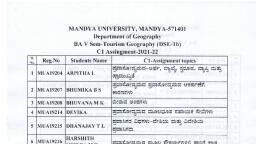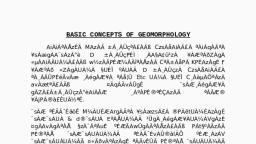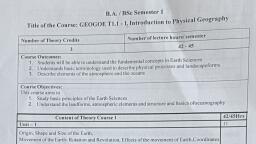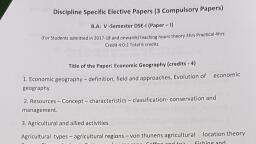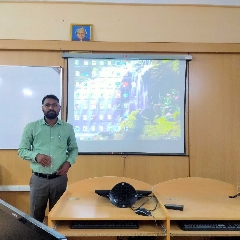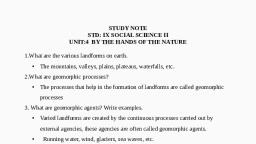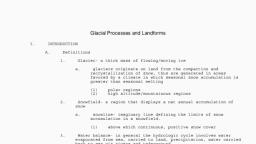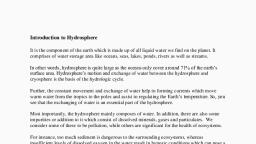Page 1 :
BASIC CONCEPTS OF GEOMORPHOLOGY, The word “Geomorphology” comes from the greek roots “geo”, “morpho” and “logos”, meaning “earth”, “forms” and “study”, respectively. Therefore geomorphology is literally “the study, of earth forms”. Geomorphologists are primarily concerned with the study of earth’s surficial, features, including their origin and evolution and impact on human activity. The basic or, fundamental concepts of geomorphology are as follows:, 1. The same physical processes and laws that operate today operated throughout geologic, time, although not necessarily with the same intensity as now., This is the important principle of geology and is known as the principle of, uniformitarianism. It was first enunciated by Hutton in 1785. According to Hutton "the present is, the key to the past". According to him geologic processes operated throughout geologic time with, the same intensity as now. We know that it is not true. Glaciers were much more significant during, the Pleistocene and during other periods of geologic time than now; world climates have not, always been distributed as they now are, and, thus, regions that are now humid have been desert, and areas now desert have been humid. There are numerous examples which shows that the, intensity of various geologic processes has varied through geologic time., , 2. Geologic structure is a dominant control factor in the evolution of landforms and is, reflected in them., The major controlling factor in land form development is structure and process. Here the, term structure includes not only the folds, faults etc. but all those ways in which the earth, materials out of which land forms are carved differ from one another in their physical and, chemical attributes. it includes such as rock attitudes; presence or absence of joints, bedding, planes, faults, and folds; rock massiveness; hardness of constituent minerals; the susceptibility of, the mineral constituents to chemical alteration; permeability and impermeability of rocks; and, various other ways by which the rocks of the earth crust differ from one another. The term, structure also has stratigraphic implications, and knowledge of the structure of a region implies as, appreciation of rock sequence, both in outcrop and in subsurface, as well as regional relationship, of the rock strata., In general the structures are much older than the geomorphic forms developed upon, them. Such major structural features as folds and faults may go back to far distant periods of, diastrophism., , 3. To a large degree the earth's surface possesses relief because the geomorphic, processes operate at different rates., The rocks of the earth's crust vary in their lithology and structure and hence offer varying, degrees of resistance to the gradational processes. Differences in rock composition and, structures are reflected not only in regional geomorphic variability but in the local topography as, well. The local intensity of particular processes may change notably in response to differences in, such factors as temperature, moisture, altitude, exposure, topographic configuration, and the, amount and type of vegetal cover. The microclimatic conditions may vary markedly between a, valley floor and a hilltop, between a northern and a southern exposure, and between bare ground, and that with a heavy vegetal cover. The rate of all weathering, all mass-wasting, all erosion, and, all deposition varies appreciably within rather narrow limits in relation to the influence of local, conditioning factors., , 4. Geomorphic processes leave their distinctive imprint upon land forms, and each, geomorphic process develops its own characteristic assemblage of land forms., , www.shaileshchaure.com 1|3
Page 2 :
The term process applies to the many physical and chemical ways by which the earth's, surface undergoes modification. In general endogenetic processes (originate from forces within, the earth crust such as diastrophism and volcanism) tend to build up or restore areas which have, been worn down by the exogenetic processes (results from external forces like weathering, maswasting, erosion); otherwise the earth's surface would finally become largely featureless. Just like, plants and animals land forms have their individual distinguishing features depending upon the, geomorphic process responsible for their development., A proper appreciation of the significance of process in land form evolution not only gives a, better picture of how individual land forms develop but also emphasizes the genetic relationships, of landform assemblages. Land forms are not haphazardly developed with respect to one another, but certain forms may be expected to be associated with each other. Thus the concept of certain, types of terrain becomes basic in thinking of geomorphologist. Most landscape are the products of, a group of processes. The complex of geomorphic processes and agents which operates under a, particular set of climatic conditions has been termed a morphogenetic system., , 5. As the different erosional agents act upon the earth's surface there is produced an, orderly sequence of land forms., The land forms possess distinctive characteristics depending upon the stage of their, development. This idea was most stressed by W. M. Davis and out of this idea grew his concept, of geomorphic cycle and its concomitant stages of youth, maturity, and old age culminating in a, topographic surface of low relief called peneplain. Use of the term geomorphic cycle will carry with, it implication of orderly and sequential development but there will be no implication that, designation of the topography to a certain area as youthful, mature or old means that the, topography of another region in the same stage of development has fully comparable, characteristics. Under varying conditions of geology, structure, and climate land form, characteristics may vary greatly even though the geomorphic processes may have been acting for, comparable periods of time. Partial cycles are more likely to occur than completed ones, for much, of the earth's crust is restive and subject to intermittent and differential uplifts., , 6. Complexity of geomorphic evolution is more common than simplicity., Usually most of the topographic details have been produced during the current cycle of, erosion, but there may exist within as area remnants of features produced during prior cycles., Commonly we are able to recognise the dominance of one cycle. Horberg (1952) divided the, landscapes into five major categories:, (1) simple, (2) compound, (3) monocyclic, (4) multicyclic and (5) exhumed., Simple landscapes are those which are the product of a single dominant geomorphic, process, compound landscapes are those in which more than one geomorphic processes have, played major role in the development of existing topography. Monocyclic landscapes are those, that bear the imprint of only one cycle of erosion; multicyclic landscapes have been produced, during more than one cycle of erosion. Much of the earth's topography bears the imprints of more, than one period of erosion. Exhumed or resurrected landscapes are those which were formed, during some past period of geological time, then buried beneath a cover mass of igneous or, sedimentary origin, then still later exposed through removal of the cover. Topographic features, now being exhumed may date back as far as the Precambrian or they may be as recent as, Pleistocene., , 7 Little of the earth's topography is older than tertiary and most of it no older than, Pleistocene., Most of the details of our present topography probably do not date back of the, Pleistocene, and certainly little of it existed as surface topography back of the tertiary. The, , www.shaileshchaure.com 2|3
Page 3 :
Himalayas were probably first folded in the Cretaceous and later in the Eocene and Miocene but, their present elevation was not attained until the Pleistocene and most of the topographic details, in Pleistocene or later in age., , 8. Proper interpretation of present-day landscape is impossible without a full appreciation, of the manifold influences of the geologic and climatic changes during the Pleistocene., Pleistocene have had far-reaching effects upon present-day topography. Glaciation, directly affected many million square miles, perhaps as much as 10,000,000 square miles, but its, effects extended far beyond the areas actually glaciated. Glacial outwash and windblown, materials of glacial origin extended into areas not glaciated, and climatic effects were probably, worldwide in extent. In the middle latitude regions the climatic effects were profound. There is, indisputable areas evidence that many regions that are today arid or semiarid had humid climates, during the glacial ages. Although glaciation was probably the most significant event of the, Pleistocene, we should not loose sight of the fact that in many areas the diastrophism which, started during the Pliocene continued into the Pleistocene and even into the Recent. Around the, Pacific Ocean, Pleistocene diastrophism has played a most significant role in shaping of presentday landscapes., , 9. An appreciation of world climate is necessary to a proper understanding of the varying, importance of the different geomorphic processes., Climatic variations may affect the operation of geomorphic processes either indirectly or, directly. The indirect influences are largely related to how climate affects the amount, kind, and, distribution of the vegetal cover. The direct controls are such as the amount and kind of, precipitation, its intensity, the relation between precipitation and evaporation and daily range of, temperature, whether and how frequently the temperature falls below. There are, however, other, climatic factors whose effects are less obvious, such as how long the ground is frozen,, exceptionally heavy rainfalls and their frequency, seasons of maximum rainfall, frequency of, freeze and thaw days, differences in climatic conditions as related to slopes facing the sun and, those not so exposed, the differences between conditions on the windward and leeward sides of, topographic features transverse to the moisture-bearing winds, and the rapid changes in climatic, conditions with increase in altitude., , 10. Geomorphology, although concerned primarily with present day landscapes, attains its, maximum usefulness by historical extension., Geomorphology concerns itself primarily with the origins of the present landscape but in, most landscapes there are present forms that date back to previous geological epochs or periods., A geomorphologist is thus forced to adopt an historical approach if he is to interpret properly the, geomorphic history of a region. The paleo-geomorphology covers the identification of ancient, erosion surfaces and study of ancient topographies., , Reference, Thornbury W.D. (2002), Principles of Geomorphology, CBS Publishers & Distributors, New Delhi,, India., , www.shaileshchaure.com 3|3

